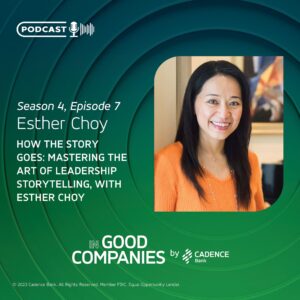January 30, 2024 / Esther Choy
Studies show that we learn and retain information best through listening to stories.
Research by The London School of Business shows that most people only retain 5-10% of information when presented with facts, but if those facts are woven into a story, listeners will remember up to 70% of that information.
Esther recently had the chance to connect with Patrick Pacheco, host of the In Good Companies podcast, to dive into leadership storytelling’s ability to transform the way you do business. They cover a variety of topics, from how much vulnerability leaders should exhibit through their storytelling, to the simple secret behind writing a great business story, and what Esther’s “Chief Story Facilitator” role really means.
As Esther describes it, “I am pretty decent in my storytelling craft, but the emphasis isn’t about me and delighting everyone with my stories or telling my stories. The central role is about facilitating others, either individually or as a group, to find and source the best story ideas they can find, refine them, and tell them in such a way that is most convincing to their intended audience.”
Staying true to this role, Esther uses a few crazy-good questions to draw the beginnings of a leadership story from Patrick’s experiences.
Telling good stories is a skill that can benefit any business context, and this podcast episode details the steps you can take to master the art of leadership storytelling.
Storytelling: The Pervasive and Persuasive Tool Leaders Need
Storytelling is particularly useful in a business context because it is a key to persuasion and a pervasive tool that can be used in any situation where meaningful and authentic communication is needed. For example, Esther shares her own leadership story where, as an admissions officer for a competitive and prestigious school, she saw only a fraction of highly qualified applicants make the cut.
Those who told their stories in a way that resonated with the decision-makers were the ones admitted. “So I eventually realized that in a competitive environment, having the right qualifications is just the first half of it,” Esther explains. “The second half is telling your stories in such a way that would resonate with gatekeepers and decision makers because they’re making decisions for the present and the future.”
We see this play out in the real world, like in the 1992 presidential election. Candidate Ross Perot, skilled in economics, presented facts and data. “And then you had Bill Clinton who was just talking about a little town called Hope. Bill was just much softer and played on that leadership of hope and he would just pull people in,” Patrick says. “ So it is pretty helpful in explaining the importance of a leader being able to be a good storyteller.”
Storytelling also gives leaders the chance to authentically connect with their audience. “How do you balance vulnerability as a leader?” Patrick asks. “You’ve got to be the boss and you don’t want to lose that, but you also want people to know that you’re human. And it seems like storytelling would be a good way to do that.”
A Whole Brain Experience
What can make stories so effective is the way our brains are wired to receive them. “The science checks out. Our brains are wired to engage with stories,” Patrick says. Listening to a story is an immersive and memorable experience.
For example, let’s say a soccer player is giving a vivid retelling of a corner kick during a game. “It’s not just that I decode what you’re saying to me through words and language,” Esther shares, “but in the part of my brain that also activates actions, that controls motions such as walking and running and kicking, all of those regions of the brain will be activated as well. So story listening, storytelling, is a whole brain experience, and that’s why people tend to remember stories.” We remember good stories, even if we can’t remember when or where we heard them.
Sharpening Your Leadership Storytelling Skills
Patrick and Esther talk about the importance of a “conceptual core,” and how listening to and collecting stories can help us identify it. Our storytelling is most effective when we are clear on what our story is really about. In listening to others tell stories, in most cases, they think the more details and information they include, the more intriguing and persuasive the story will be. Esther details how, with her clients, the essential first step is identifying the conceptual core of the story. This allows them to decide what details are relevant and which ones are not, and put all their storytelling power behind that concept that they really want their audience to remember.
A Leadership Storytelling Example
Since leadership storytelling is about showing, not just telling, Esther creates the beginning of a story using anecdotes Patrick provides about his favorite hobby and his experience the morning of September 11th, 2001. To hear the full story, listen to the In Good Companies podcast episode, How the Story Goes: Mastering the Art of Leadership Storytelling, with Esther Choy.
If you’re ready to try your hand at a leadership story, learn the fundamental storytelling framework, test new ideas, and receive constructive feedback, by joining our next complimentary Story Lab.
Better Every Story
"This is an amazing and insightful post! I hadn’t thought of that so you broadened my perspective. I always appreciate your insight!" - Dan B.
Join the thousands who receive Esther Choy’s insights, best practices and examples of great storytelling in our twice monthly newsletter.



